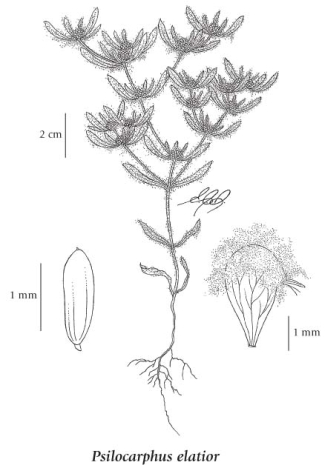Psilocarphus elatior (A. Gray) A. Gray
tall woolly-heads (meadow woollyheads)
Asteraceae (Aster family)
Introduction to Vascular Plants
tall woolly-heads (meadow woollyheads)
Asteraceae (Aster family)
Introduction to Vascular Plants
Species Information
General:
Annual herb from a short taproot; stems erect, moderately branched above, decumbent below, 5-15 cm tall.
Leaves:
Basal leaves lacking; stem leaves oppposite, linear to oblong, moderately silky woolly-hairy, 0.5-3.5 cm long, 2-6 mm wide.
Flowers:
Heads disciform, usually solitary in leaf axils or at tips of branches; involucres lacking; receptacular bracts hooded and balloonlike, 2.5-3.8 mm long at maturity; female flowers mostly 20-80, rarely as few as 8 in dwarfed forms.
Fruits:
Achenes nerveless, more or less cylindric, glabrous, tipped with a small style, 1.0-1.7 mm long; pappus lacking.
Illustration

If more than one illustration is available for a species (e.g., separate illustrations were provided for two subspecies) then links to the separate images will be provided below. Note that individual subspecies or varietal illustrations are not always available.
Illustration Source: The Illustrated Flora of British Columbia
Habitat and Range
Moist vernal meadows and muddy pathsides in the lowland zone; rare on S Vancouver Island; E to AB and SK and S to ID and N CA.Status Information
| Origin Status | Provincial Status | BC List (Red Blue List) | COSEWIC |
|---|---|---|---|
| Native | S2 | Red | E (May 2018) |
BC Ministry of Environment: BC Species and Ecosystems Explorer.
Synonyms
Synonyms and Alternate Names:
Psilocarphus oreganus var. elatoir
Similar Species
Young Psilocarphus elatior plants are frequently difficult to separate from young Gnaphalium palustre and G. uliginosum plants, with which they often grow. Gnaphalium plants differ in having alternate leaves and round, flat, densely woolly flower heads with broad ray (single petal) flowers (Douglas et al. 2001a).
Source: British Columbia Conservation Data Centre |